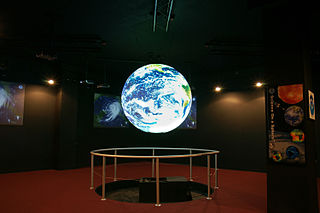
The John F. Kennedy Space Center is one of ten National Aeronautics and Space Administration field centers. Since December 1968, Kennedy Space Center has been NASA's primary launch center of human spaceflight. Launch operations for the Apollo, Skylab and Space Shuttle programs were carried out from Kennedy Space Center Launch Complex 39 and managed by KSC. Located on the east coast of Florida, KSC is adjacent to Cape Canaveral Air Force Station (CCAFS). The management of the two entities work very closely together, share resources, and even own facilities on each other's property.

Atmospheric entry is the movement of an object from outer space into and through the gases of an atmosphere of a planet, dwarf planet, or natural satellite. There are two main types of atmospheric entry: uncontrolled entry, such as the entry of astronomical objects, space debris, or bolides; and controlled entry of a spacecraft capable of being navigated or following a predetermined course. Technologies and procedures allowing the controlled atmospheric entry, descent, and landing of spacecraft are collectively termed as EDL.

Spaceflight is ballistic flight into or through outer space. Spaceflight can occur with spacecraft with or without humans on board. Yuri Gagarin of the Soviet Union was the first human to conduct a spaceflight. Examples of human spaceflight include the U.S. Apollo Moon landing and Space Shuttle programs and the Russian Soyuz program, as well as the ongoing International Space Station. Examples of unmanned spaceflight include space probes that leave Earth orbit, as well as satellites in orbit around Earth, such as communications satellites. These operate either by telerobotic control or are fully autonomous.

Cape Canaveral Air Force Station (CCAFS) is an installation of the United States Air Force Space Command's 45th Space Wing.
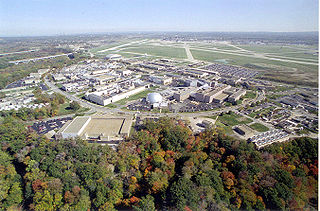
NASA John H. Glenn Research Center at Lewis Field is a NASA center, located within the cities of Brook Park and Cleveland between Cleveland Hopkins International Airport and the Rocky River Reservation of Cleveland Metroparks, with a subsidiary facility in Sandusky, Ohio. Its director is Janet L. Kavandi. Glenn Research Center is one of ten major NASA field centers, whose primary mission is to develop science and technology for use in aeronautics and space. As of May 2012, it employed about 1,650 civil servants and 1,850 support contractors located on or near its site.

Robert Laurel Crippen is an American retired naval officer and aviator, test pilot, aerospace engineer, and retired astronaut. He traveled into space four times: as Pilot of STS-1 in April 1981, the first Space Shuttle mission; and as Commander of STS-7 in June 1983, STS-41-C in April 1984, and STS-41-G in October 1984. Crippen received the Congressional Space Medal of Honor.

The John C. Stennis Space Center (SSC) is a NASA rocket testing facility. It is located in Hancock County, Mississippi, on the banks of the Pearl River at the Mississippi–Louisiana border. As of 2012, it is NASA's largest rocket engine test facility. There are over 30 local, state, national, international, private, and public companies and agencies using SSC for their rocket testing facilities.
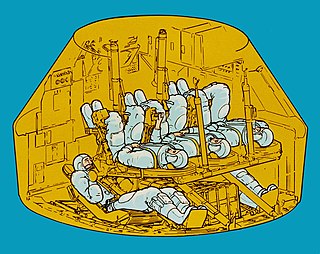
The Skylab Rescue Mission was a backup rescue flight as part of a contingency plan for the Skylab space station. It used a modified Apollo Command Module that could be launched with a crew of two and return a crew of five.
Orbital Sciences Corporation was an American company specializing in the design, manufacture and launch of small- and medium- class space and rocket systems for commercial, military and other government customers. In 2014 Orbital merged with Alliant Techsystems to create a new company called Orbital ATK, Inc., which in turn was purchased by Northrop Grumman in 2018.

Little Joe II was an American rocket used from 1963–1966 for five unmanned tests of the Apollo spacecraft launch escape system (LES), and to verify the performance of the command module parachute recovery system in abort mode. It was named after a similar rocket designed for the same function in Project Mercury. Launched from White Sands Missile Range in New Mexico, it was the smallest of four launch rockets used in the Apollo program.
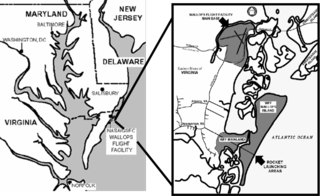
Wallops Flight Facility (WFF), located on the Eastern Shore of Virginia, United States, approximately 100 miles (160 km) north-northeast of Norfolk, is operated by the Goddard Space Flight Center in Greenbelt, Maryland, primarily as a rocket launch site to support science and exploration missions for NASA and other Federal agencies. WFF includes an extensively instrumented range to support launches of more than a dozen types of sounding rockets; small expendable suborbital and orbital rockets; high-altitude balloon flights carrying scientific instruments for atmospheric and astronomical research; and, using its Research Airport, flight tests of aeronautical research aircraft, including unmanned aerial vehicles.

The Kennedy Space Center Visitor Complex is the visitor center at NASA's Kennedy Space Center in Florida. It features exhibits and displays, historic spacecraft and memorabilia, shows, two IMAX theaters, and a range of bus tours of the spaceport. "Space Shuttle Atlantis" is home to the real Space Shuttle Atlantis orbiter and the Shuttle Launch Experience, a simulated ride into space. The center also provides astronaut training experiences, including a multi-axial chair and Mars Base simulator. The visitor complex also has daily presentations from a veteran NASA astronaut. A bus tour, included with admission, encompasses the separate Apollo/Saturn V Center. There were 1.7 million visitors to the visitor complex in 2016.

A rocket garden is a display of missiles, sounding rockets, or space launch vehicles usually in an outdoor setting. The proper form of the term usually refers to the Rocket Garden at the Kennedy Space Center Visitor Complex.

Space Center Houston is a leading science and space learning center, the official visitor center of NASA Johnson Space Center in Houston and a Smithsonian Affiliate museum. The organization is owned and operated by the nonprofit Manned Spaceflight Education Foundation, a 501(c)(3) organization. The Johnson Space Center is the home of Mission Control and astronaut training.

The Mid-Atlantic Regional Spaceport (MARS) is a commercial space launch facility located at the southern tip of NASA's Wallops Flight Facility on Wallops Island in Virginia, just east of the Delmarva Peninsula and south of Chincoteague, Virginia, United States.
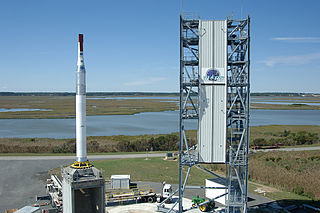
ALV X-1 was to be a sounding rocket flight of a vehicle developed by Alliant Techsystems called the ATK Launch Vehicle (ALV). The rocket carried the SOAREX-VI and Hy-BoLT experiments as payloads. The flight was launched at 09:10 GMT on August 22, 2008, and then the rocket was intentionally destroyed 20 seconds into flight after veering too far off course. Launch occurred from LP-0B at the Mid-Atlantic Regional Spaceport (MARS) at NASA's Wallops Flight Facility.

The National Aeronautics and Space Administration is an independent agency of the United States Federal Government responsible for the civilian space program, as well as aeronautics and aerospace research.

Launch Pad 0, Pad 0 or LP-0, also known as Launch Complex 0, Launch Area 0 or LA-0, is a launch complex at the Mid-Atlantic Regional Spaceport (MARS) on Wallops Island, Virginia in the United States. MARS is located adjacent to NASA's Wallops Flight Facility (WFF), which ran the launch complex until 2003. WFF continues to provide various support services to MARS launches under contract with the Commonwealth of Virginia.

The Virginia Air and Space Center is a museum and educational facility in Hampton, Virginia that also serves as the visitors center for NASA's Langley Research Center and Langley Air Force Base. The museum also features an IMAX digital theater and offers summer aeronautic- and space-themed camps for children.

Cygnus CRS Orb-1, also known as Orbital-1, was the second flight of the Orbital Sciences Cygnus unmanned resupply spacecraft, its second flight to the International Space Station and the third launch of the company's Antares launch vehicle. The mission launched January 9th, 2014 at 1:07 PM.





